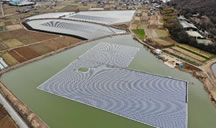Recruiting Talent in the AgriTech Industry
If you look at the schools today vs. even 5-7 years ago, many more are offering degrees in Ag Tech and CEA. This allows many more students to pursue this as a course of study, and hopefully have increased opportunity after they graduate.
Barilla Foundation: "An Urgent Rethink of the Global Food System Is Needed"
-Global food systems generate $12 trillion of hidden costs, from environmental damage to public health
-Revolutionizing current agri-food systems would bring economic returns of around $5.7 trillion, creating new business opportunities of up to $4.5 trillion each year by 2030 and creating environmental and health benefit
Precision Farming Market to cross USD 12 billion by 2025
The remote sensing technology in the precision farming market is expected to witness a growth rate of over 17% over the forecast timeline.
HYOSHIGA IKE: ANOTHER CIEL & TERRE'S FLOATING PV PLANT IN JAPAN, PRESERVING (AGRI)CULTURE
This solar array, located in Kobe City, Kobe, has taken into account both agriculture and a historical feature of the site…
Feeding a Growing Population: Why Technology Matters
If we can incorporate technology into already existing farming practices, we can increase production enough to feed the growing world. Technology can be used to grow more food on existing farms and to grow food in small spaces, such as indoor farms.
World's first floating farm in the Netherlands
Mina Solanki for IAmExPat: Floating Farm will be made from a concrete base and will measure around 1.000 square metres. The roof will be fitted with solar panels and a rainwater collection system.
AgriTech In India: How Startups Are Changing The Face Of Indian Agriculture
AgriTech Investors Roundtable: According to the latest report, for 2016, over $3.23 Bn was invested in agriculture sector worldwide. Of this, 53 Indian agritech startups raised $313 Mn.
Automating One Acre Under Glass
Richmond Nursery in Ontario Saves More Than $50,000 a Year Using an Leviton Environmental Control System
Records 1 to 8 of 8
Featured Product

Elmo Motion Control - The Platinum Line, a new era in servo control
Significantly enhanced servo performance, higher EtherCAT networking precision, richer servo operation capabilities, more feedback options, and certified smart Functional Safety. Elmo's industry-leading Platinum line of servo drives provides faster and more enhanced servo performance with wider bandwidth, higher resolutions, and advanced control for better results. Platinum drives offer precise EtherCAT networking, faster cycling, high synchronization, negligible jitters, and near-zero latency. They are fully synchronized to the servo loops and feature-rich feedback support, up to three feedbacks simultaneously (with two absolute encoders working simultaneously). The Platinum Line includes one of the world's smallest Functional Safety, and FSoE-certified servo drives with unique SIL capabilities.








